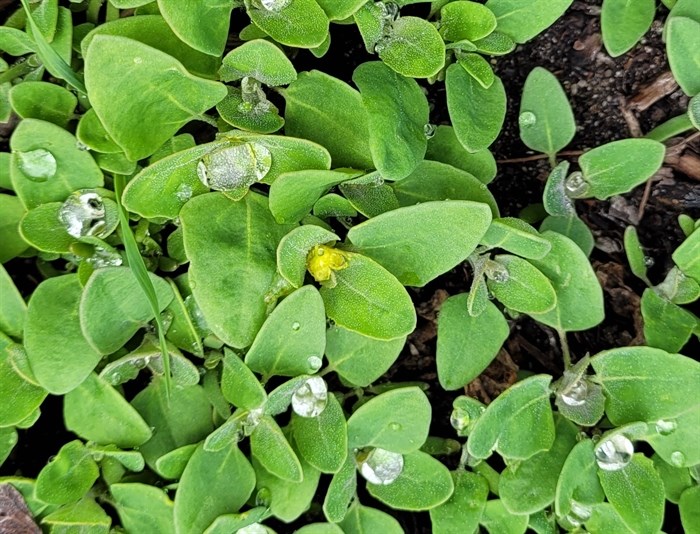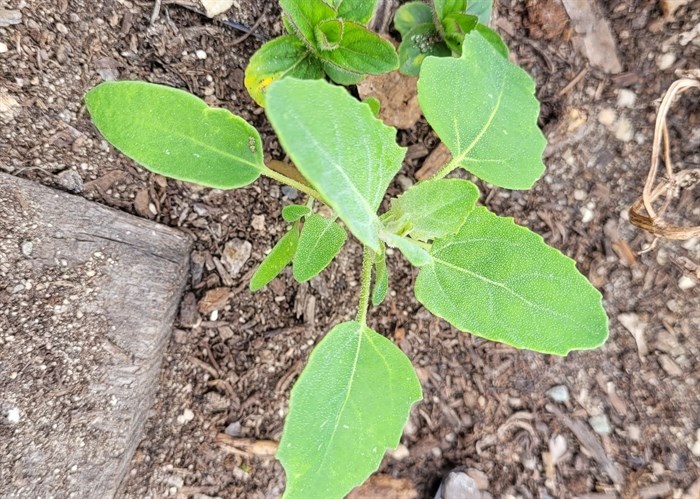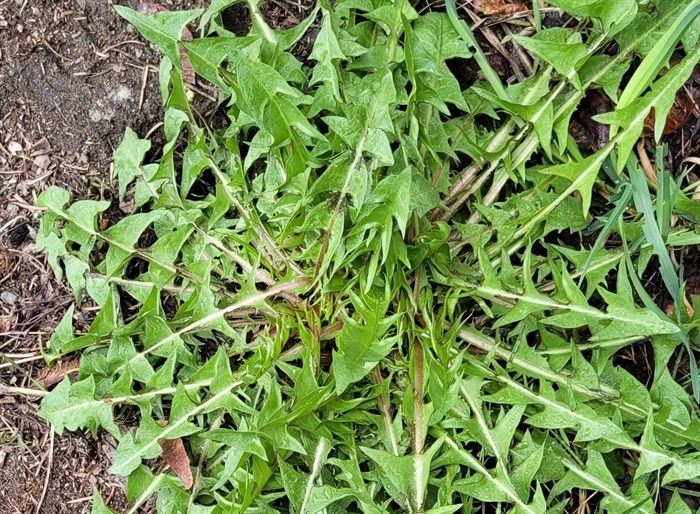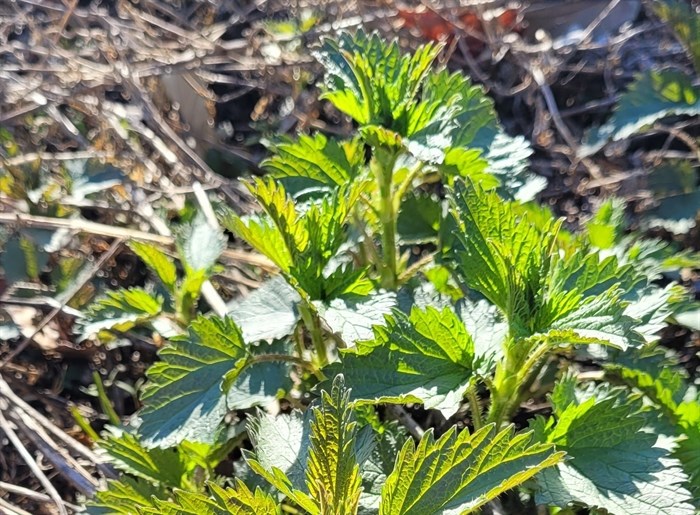
A young lamb's quarters plant growing in a backyard in Summerland.
Image Credit: SUBMITTED/Sarah Willard Smits
April 23, 2022 - 6:00 AM
While gardeners in the Okanagan and Kamloops are pulling out and disposing of pesky weeds, they are likely also tossing out some tasty eats.
Sarah Willard Smits is a community herbalist based in Summerland and owner of 13 Moons Apothecary. She has 26 years of experience in the field.
Smits said many backyards and outdoor spaces are full of edible plants that are loaded with nutrition. She is reviewing three edible plants that can be found across North America and are some of the easiest for beginners to identify: lamb’s quarters, nettles and dandelions.
“I want to stick with plants that are common and have a flavour profile that might entice more people to learn about edible plants,” she said. “The more people have an interest in eating natural foods the more we will naturally want to take better care of our environment.”
Smits takes people out every week on plant identification or foraging walks depending on what is growing. She recommends that beginners find a local specialist or join a horticultural group before consuming wild plants.
“There are some lookalikes, you need to go with someone who is a local expert until you are comfortable,” she said. “Local specialists have been using the plants and know what they are, and what parts are edible at what times in the season.”
READ MORE: iN VIDEO: Watch 12 months of Kamloops garden's life in 12 seconds
Smits said once people are shown a plant, they suddenly realize they are everywhere around them. She recommends harvesting where you know there haven’t been pesticides used, and not on roadsides.
Many plants have different common names, so using a plant’s Latin name is a reliable way to ensure people are identifying the same plant.

A young lamb's quarters plant growing in Summerland.
Image Credit: SUBMITTED/Sarah Willard Smits
“Lamb’s quarters is the most widely spread and most prolific plant besides grasses on the planet,” Smits said. “It is an annual in the amaranth family just like spinach and quinoa. You use the tender green leaves like spinach year round and harvest the seeds in late autumn.”
Smits eats the leaves raw or steams them, and uses them in recipes as a spinach substitute.
“The leaves have a mild flavour and are a nutritional powerhouse,” she said. “I put them into salads, lasagna and omelettes.”
The seeds take work because you have to get the chaff off of them. Smits separates the seeds from the chaff by rubbing the seeds between her palms over a plastic bowl. The static in the bowl causes the chaff to stick to it, and the seeds drop out.
READ MORE: SPRING IS COMING: Gardening centres begin opening in Okanagan, Kamloops
“It is time consuming but they taste good and can be eaten whole or ground,” Smits said. “I roast them in the oven and put them on oatmeal and salads.”
Lamb’s quarters grows in all different soils and you never have to worry about over harvesting. It is an herbaceous plant with great variation in leaf shape. Leaves are green with thick, ribbed stems that range in colour from reddish-purple to light silver-green.

A pre-flowering dandelion plant growing in Summerland.
Image Credit: SUBMITTED/Sarah Willard Smits
Dandelions are a very widely distributed weed of the daisy family and the whole plant is edible, which includes the leaves, flowers and roots.
“The ideal time to eat the leaves is before flowering or they will taste bitter,” Smits said. “They taste like arugula. I chop them up a little and add them to salads or stir fry recipes. If it is too bitter, I boil it in salty water to mellow the flavour.”
Smits puts the dandelion flowers directly onto salads, and makes tea with them.
“The flowers are delicious,” she said. “They are sweet like a honey chamomile. Some people make wine out of them. Having them as a tea is a palatable way to try them.”
Dandelion roots can be scrubbed, chopped, dried and roasted to make a dry coffee substitute. Smits said all parts of the plant are full of vitamins and minerals and are a particularly good source of vitamin K.
Dandelions have a rosette of leaves and bright yellow flowers that turn into heads of seeds with downy tufts.

A stinging nettle plant growing in Summerland.
Image Credit: SUBMITTED/Sarah Willard Smits
Stinging nettles are another prolific edible plant, and one you need to pick with gloves on. The plants are used as a spinach substitute and the seeds can be harvested in August.
“The stinging comes from formic acid but as soon as it is picked it is oxidized and loses most of its sting,” Smits said. “It tastes like a cross between spinach and okra, and is wonderful for making thick gumbo stew. We have put them over rice, on veggie burgers and in omelettes. You can dry them in an oven to make a tea leaves to use as a superfood in the winter months.”
READ MORE: 'It's no small ordeal to build your own home,' Okanagan tiny home workshop shows you how to do it
Smits said stinging nettle has the same electrolytes that Gatorade has. In the summer the seeds can be picked and both plant parts are energizing when eaten.
“With the seeds I just dry them and put them on porridge or in my smoothies, they have a nice crunch to them,” she said. “I pick the nettles’ stalks and hang them upside down and the seeds fall out. Then I put them on my table and carefully strip the seed part.”
Stinging nettle has pointed leaves and white to yellowish flowers. Smits recommends not eating the leaves of the nettle after it gets big.
Smits is currently obtaining her educational status as a master herbalist through the Wild Rose College of Herbal Medicine. She has always had an interest in health and wellness. She has experience in making herbal tinctures and formulations, tea blends and therapeutic-grade essential oils. She has studied many local plants.
Currently, Smits has a booth at both the Penticton Farmers' Market and The Summerland Sunday Market and offers various workshops, and plant identification and foraging walks.
To learn more or to connect with Sarah Smits, click here.
To contact a reporter for this story, email Shannon Ainslie or call 250-819-6089 or email the editor. You can also submit photos, videos or news tips to the newsroom and be entered to win a monthly prize draw.
We welcome your comments and opinions on our stories but play nice. We won't censor or delete comments unless they contain off-topic statements or links, unnecessary vulgarity, false facts, spam or obviously fake profiles. If you have any concerns about what you see in comments, email the editor in the link above.
News from © iNFOnews, 2022